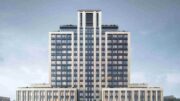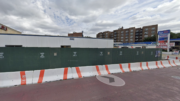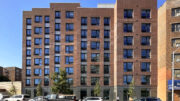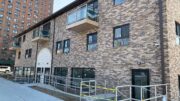There it sits, the northern portion of the deactivated Rockaway Beach Branch rail line, a 3.5 mile-long right-of-way in central and southern Queens that last saw passenger service in 1962. One MTA board member described it to YIMBY as “the most valuable dormant right of way in the world.” This may be hyperbole, but the site’s inherent value is indeed tantalizing.
It is this sense of value that has led to some well-meaning advocates, dismayed by its current decrepit state, to propose active uses for the Rockaway Beach Branch. One proposal, the QueensWay, would create an elevated park and walk-bike trail that its proponents have likened to the High Line on Manhattan’s West Side. The other proposal is to reactivate the line for passenger service, either by linking the line with the Long Island Rail Road or the Queens Boulevard subway line. Reactivation could also take the form of a 26-minute ride from Penn Station to the Howard Beach AirTrain station.
None of these ideas are bad in theory, but given the area’s existing built environment and population density, as well as the reluctance by local community boards to allow any significant new development, it is difficult to rationalize the significant investments needed for either of these proposals – at least at this time.
When one takes into account competing needs across the city and a scarcity of funding for essential projects, it may be that this is simply not the right decade to pursue either option. The right-of-way isn’t going anywhere; it will still be there when the city and surrounding communities get serious about redeveloping southern Queens.
Proponents of the QueensWay say that it would cost about $122 million to construct, or about $2.6 million per acre, with another $4 million annually for maintenance and upkeep. It is difficult to determine the accuracy of these cost estimates, though one may be inclined to round up. A similar project in Chicago called the 606—which QueensWay advocates hold up as a relevant case study—cost $6 million per acre to construct. The High Line cost $25 million per acre, though the design of the QueensWay would be much more humble than its Manhattan counterpart.
Meanwhile, the city’s existing parks must fight for their share of a miniscule parks budget. The $122 million needed for the QueensWay would be around a third to half of the city’s current annual capital contribution to parks. As it is, many parks are already in dire need of improvements – Flushing Meadows-Corona Park is just one example.
And while the High Line was able to move forward because of hefty private donations, it is unlikely that the QueensWay would have the same kind of constituency as the High Line, which passes through the tony Meatpacking district and Chelsea. Ask any non-profit leader in Queens – especially this part of Queens – how easy it is to secure donations and support from their local communities, and you’ll quickly find strains of doubt about the QueensWay’s financial feasibility seeping in.
As the QueensWay proposal has gained momentum, others have countered that the best use for the right-of-way is to restore transit service. Residents of southern Queens and the Rockaways have some of the longest commutes in the city, with over one-third of workers along the right-of-way having one-way commutes of over an hour. In four of the census tracts abutting the line, more than half of all commuters pass that threshold.
But a recently released study by Queens College shows that ridership on any new transit link is likely to be very low – too low to justify the investment, at least in our opinion. The study didn’t estimate the ridership of a reactivated Rockaway Beach Branch line, but it did examine the number of trips made to and from the neighborhoods bordering the right of way as a way to gauge the potential impact of restoring rail service.
Those trying to get from the Rockaways and southern Queens to points north and west would benefit the most, the study’s authors conclude. About 357,000 trips are made on an average weekday between these areas, and 47 percent of these trips are made by car. Ridership would be significantly lower, as many residents of these neighborhoods do not live close enough to new stations to utilize the new service, and some will always prefer to drive.
There is no evidence to suggest that the line would would “attract” 500,000 subway trips a day, as was reported in several news outlets. As a comparison, subway stations in Queens hosting A and J/Z service saw a bit under 130,000 boardings each weekday in 2013.
Estimates about the cost of reactivating the northern portion of the Rockaway Beach Branch for passenger service vary wildly. The authors of the Queens College study did not estimate the cost of reactivating the line for rail service, but they did list some cost estimates from previous proposals. These range from $592 million to $2.77 billion for service to JFK and $1.25 billion for a proposal that would allow both A train service and commuter rail to the Rockaways by building a parallel train trestle across Jamaica Bay.
And there are, of course, plenty of other capital projects that any rail reactivation proposal would have to compete with for funding. The East Harlem leg of the Second Avenue subway is already in the MTA’s next capital plan, half of which is unfunded. Beyond that, Rockaway Beach Branch reactivation proponents would need to make the case that the project is more worthwhile than finishing the Nostrand Avenue subway and starting the Utica Avenue one in Brooklyn – areas with higher ridership on existing bus lines than the southern Queens neighborhoods that the Rockaway Beach Branch cuts through – or improving bus service throughout the five boroughs.
And then there is the question of the quality of service. Residents of the Rockaways wouldn’t necessarily benefit from converting the A train to commuter rail, which would bring a significantly higher fare and much less frequent service. Until the Long Island Railroad operates more like its European counterparts, with subway-like frequency, staffing, and fare integration, this option would not bring substantial benefits.
The most intriguing option would be the link to the JFK AirTrain. This would require designing rail cars that could operate on both LIRR and AirTrain tracks, and cutting through the bureaucratic red tape that divides the LIRR and the Port Authority. While it may be technically feasible, the MTA is severely hampered in its ability to carry out capital projects, and the bureaucratic challenges would be daunting.
There is also the question of whether a planned rapid bus route for Woodhaven Boulevard could meet the transit needs of these communities at a more reasonable cost. The city is currently in the planning phases to introduce Select Bus Service along Woodhaven and Cross Bay Boulevard, at a cost of approximately $200 million. If done right, the new service could effectively link the Rockaways and the neighborhoods to the north with both the LIRR and the Queens Boulevard line. Perhaps instead of agitating for Rockaway Beach Branch reactivation, proponents could instead rally for true bus rapid transit along this corridor, with high-capacity buses arriving every few minutes, traveling in strict bus-only lanes with priority at traffic lights.
So far, the communities flanking the Rockaway Beach Branch have not thrown their weight behind either of the competing proposals. Many community leaders seem hostile to the idea of change, and are more concerned with preserving the low-density character of “their” neighborhoods. NIMBYs don’t want a High Line-style park in their backyards, nor are they excited about the idea of trains rumbling through.
Perhaps once these neighborhoods are ready to “grow up” and accept the next stage of development, then they will have the population density to merit significant new investments in new parks and transit. That time seems a long way off yet.
Subscribe to YIMBY’s daily e-mail
Follow YIMBYgram for real-time photo updates
Like YIMBY on Facebook
Follow YIMBY’s Twitter for the latest in YIMBYnews





